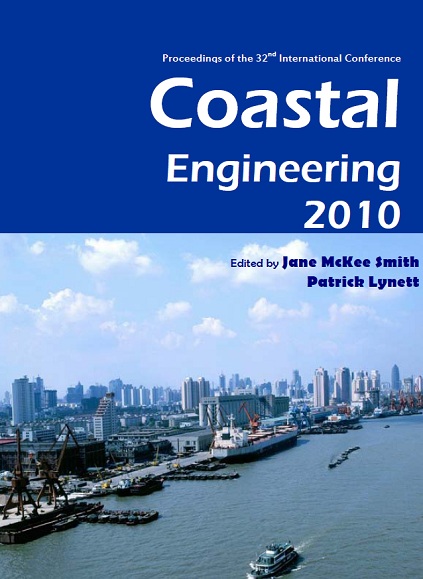Abstract
Over the last five years a research program has been carried out to assess the performance of the spectral wave model SWAN in the Wadden Sea so that it may be used for the transformation of offshore wave conditions to wave boundary conditions near the sea defenses (dikes and dunes). The assessment was done on the basis of extensive wave measurements conducted in Ameland inlet and the Dutch Eastern Wadden Sea, as well as relevant data from lakes and estuaries. After a first round of assessment, we found that SWAN performed reasonably well for storm conditions but three aspects required further attention. Firstly, focusing on the main channel, SWAN formulations needed to be modified in order to eliminate overprediction of the significant wave height in opposing currents. Secondly, the primary spectral peak of North Sea waves penetrating into the inlet was underpredicted. Best results were obtained when the refraction of low-frequency waves was limited and the bottom friction coefficient was set at a lower value than the current default for wind seas. Thirdly, over the tidal flats the computed ratio of integral wave height over water depth showed an apparent upper limit using the conventional Battjes and Janssen (1978) depth-limited wave breaking formulation, because the wave growth over finite depth is hampered by the present formulation of depth-induced wave breaking. The problem has been solved using a new breaker formulation. All these improvements have lead to a wave transformation model with which reliable wave conditions in the Wadden Sea and related complex areas can be determined.References
Alkyon (2003). Calibration of SWAN 40.20 for field cases Petten, Slotermeer, and Westerschelde. Report A1168, Author: G.Ph. van Vledder.
Alkyon (2008a). Analysis of SWAN hindcasts Wadden Sea, Oosterschelde Slotermeer; Investigation into low frequency wave energy, current effects and depthl imitation. Alkyon Report A2085.
Author: G.Ph. van Vledder.
Alkyon (2008b). SWAN hindcast in the Eastern Wadden Sea and Eems-Dollard estuary during the Storm of 9 November 2007. Alkyon Report A2191. Authors: J. Adema, G.Ph. van Vledder and O.R. Koop.
Battjes, J.A., and J.P.F.M. Janssen (1978). Energy loss and set-up due to breaking of random waves, Proceedings of 14th International Conference on Coastal Engineering, ASCE, 466-480.
Booij, N., R.C. Ris and L.H. Holthuijsen (1999). A third generation wave model for coastal regions, Part I, Model description and validation. J. Geophys. Res., 104, C4, 7649-7666. http://dx.doi.org/10.1029/98JC02622
Bouws, E. and G. J. Komen (1983). On the balance between growth and dissipation in an extreme, depth-limited wind-sea in the southern North Sea. J. Phys. Oceanogr., Vol. 13, 9, 1653-1658. http://dx.doi.org/10.1175/1520-0485(1983)013<1653:OTBBGA>2.0.CO;2
Deltares (2008). Observed finite-depth wave growth limit in the Wadden Sea. Deltares report H5107.35. Authors: A.J. van der Westhuysen and J.P. de Waal.
Deltares (2009). Penetration of North Sea waves into the Wadden Sea - phase 3: fallback options.
Deltares report report 1200114-002. Authors: A.R. van Dongeren, A.J. van der Westhuysen, G.Ph. van Vledder and I. Wenneker.
Deltares/Alkyon (2009). Wave propagation through tidal inlet systems. Deltares and Alkyon report 1200114-002-HYE-0006. Authors: A.J. van der Westhuysen, B. Huisman, F. Enet. O. Koop and G.Ph. van Vledder.
De Waal, J.P., D. Beyer, J.H. Andorka Gal, L.H. Holthuijsen, G.Ph. van Vledder, J.P.F.M. Janssen and D.P. Hurdle (1997). Instelling golfmodel HISWA. Toe te passen bij productiesommen in het IJsselmeergebied. RIZA report R0269.
Dingemans, M.W. (1998). Water wave propagating over uneven bottoms. Part 1: Linear wave propagation. Advanced Series on Ocean Engineering, Vol 13. World Scientific, Singapore. PMid:9690968
Doering, J.C. and A.J. Bowen (1995). Parametrization of orbital velocity asymmetries of shoaling and breaking waves using bispectral analysis, Coastal Engineering, vol. 26, no. 1-2, pp. 15-33. http://dx.doi.org/10.1016/0378-3839(95)00007-X
Eldeberky, Y. (1996). Nonlinear transformation of wave spectra in the nearshore zone. Ph.D. thesis, TU Delft, 203 p.
Hasselmann, K., On the non-linear energy transfer in a gravity-wave spectrum: I. General theory, J. Fluid Mech, 12, 481- 500, 1962. http://dx.doi.org/10.1017/S0022112062000373
Hasselmann, K., T. P. Barnett, E. Bouws, H. Carlson, D. E. Cartwright, K. Enke, J. A. Ewing, H. Gienapp, D. E. Hasselmann, P. Kruseman, A. Meerburg, O. Muller, D. J. Olbers, K. Richter, W.
Sell, and H. Walden (1973). Measurement of windwave growth and swell decay during the Joint North Sea Wave Project (JONSWAP). Dtsch. Hydrogr. Z. Suppl. 12(A8). doi:10.1029/2009JC005433. http://dx.doi.org/10.1029/2009JC005433
Zijlema, M. (2009). Multiscale simulations using unstructured mesh SWAN model for wave hindcasting in the Dutch Wadden Sea. Proceedings Coastal Dynamics, Tokyo, Japan.

